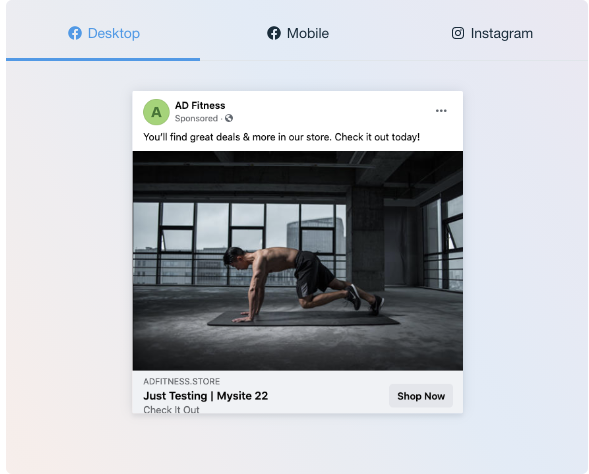Facebook Ads: Picking an Ad Format for Your Campaign
3 min
In this article
- Types of Ad Formats
- Classic Ads
- Dynamic Ads
- Which Ad Format Should I Choose?
There are two types of ad formats for Facebook Ads campaigns: classic ads and dynamic ads. The format available to you depends on your site and campaign goal.
- Classic ads: You create an ad for a product, service, or promotion and choose your own media, caption and headline. These work great for ad goals like 'promote my page' or 'more leads or bookings.'
- Dynamic ads: You connect a catalog of products and dynamic ads use machine learning to show the most relevant products to the right people.
Note: Dynamic ads are only available for the 'Get more store orders' goal.
Learn more about what type of ad format you should choose.
Types of Ad Formats
Learn more about the two types of ad formats and the benefits of choosing each one.
Classic Ads
Classic ads allow you take full control over your ad's creative by choosing the image or video shown in the ad, as well as the headline, caption and destination URL. These are best for stores that advertise less than four products and for all non-store related goals.
The benefits of choosing a classic ad:
- Fully customizable: Choose the ad's image, caption, headline and call-to-action to drive potential customers to a specific place.
- Video capabilities: With classic ads, you can choose to upload a video to make your product or service come to life in the ad.
- More focused creative: Since you get more control over the messaging, you can use a classic ad to drive potential customers to a specific sale or place on your site (like a landing page or one-off page) rather than a product page.

Tip:
Learn more about the best practices for creating classic ads.
Dynamic Ads
Dynamic ads use machine learning to deliver the most relevant products to people based on their interests and actions online. Facebook recommends using a dynamic ad if you have 4 or more products. Instead of you manually creating a different ad for every item in your store, dynamic ads pull pictures and descriptions from your product catalog. If the ad is dynamic, different people see different items based on their past interactions with your store. Learn more about dynamic ads and how store products sync with your campaign.
Important:
Dynamic ad formats only apply to campaigns with the 'get more store orders' goal.
- Less work for you: When you first connect to Facebook, your store catalog is synced as well. Dynamic ads automatically take images and descriptions from the catalog, so everything is already set up for you.
- Automation and optimization: Dynamic ads utilize machine learning and are always optimizing to make the best possible campaign. You can go about your business knowing that the right products are seen by the right people.

Tip:
Optimization works best over time. If you choose a dynamic ad, give the algorithm time to learn and optimize using the current data before making changes that could affect overall performance.
Which Ad Format Should I Choose?
If you've having trouble picking an ad format for your campaign, ask yourself the following questions:
- Do I have an online store with many products?
For online stores, dynamic ads are recommended if you have a suite of products to sell. This is because dynamic ads will cycle through different product images and create different variations of the ad based on the target audience. If you have 3 products or less to advertise, you can consider classic ads which only allows you to add one image to your ad. - How much control and customization do I want over my ads?
Classic ads give you complete customization over the media, caption, call-to-action and more while dynamic ads pull the image and description from your store catalog. - What action do I want ad viewers to take?
If you want viewers of your ad to go to a specific page of your site, use a classic ad. If you want to showcase specific products, create a dynamic ad.
Note:
While it's possible to switch ad formats while a campaign is running, it is not recommended. The ad formats have slightly different intentions so changing in the middle of a campaign could potentially affect the overall performance.


